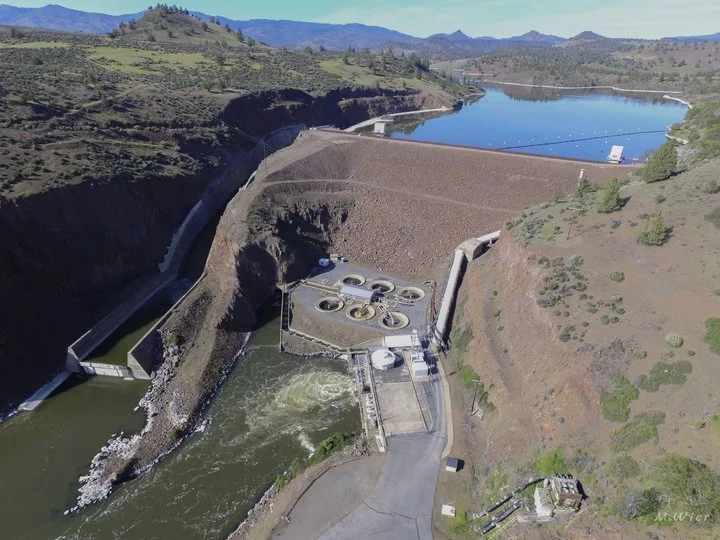Iron Gate Dam, one of four hydroelectric dams slated for removal on the Klamath River. | Michael Wier, CalTrout
###
DOCUMENT: Final Environmental Impact Statement for Hydropower License Surrender and Decommissioning
After nearly two decades of painstaking negotiations and political turbulence, the largest river restoration project in American history is set to begin early next year.
This morning, Federal Energy Regulatory Commission (FERC) staff released the long-awaited Final Environmental Impact Statement (FEIS) for license surrender, decommissioning and removal of four dams – Copco No. 1, Copco No. 2, J.C. Boyle and Iron Gate – on the Lower Klamath River, a move that would restore over 400 miles of critical salmon spawning habitat in the Klamath Basin.
The 1,242-page document contains FERC staff’s evaluation of the environmental, cultural and economic impacts associated with dam removal. In short, staff agree that dam removal is the best path forward.
“Project removal and implementation of mitigation measures proposed in management plans would protect environmental resources, restore project lands, minimize adverse effects, maximize benefits to protected fish, and restore the landscape of the areas that are currently impounded within the project reach to a more natural state,” according to the FEIS abstract. “Commission staff recommends approval of the proposed license surrender, decommissioning and removal of the project with staff additional recommendations and mandatory conditions.”
FERC commissioners will issue a final ruling on dam removal later this year. If everything goes according to plan, dam removal will begin in early 2023.
“This is amazing,” Craig Tucker, a natural resources consultant for the Karuk Tribe, told the Outpost this afternoon. “The tribal communities along the river have fought tooth and nail for two decades to get to this point. The river is struggling and the fisheries are struggling. This is the single biggest action we can take to reverse the trends of salmon decline and put the Klamath River on the road to recovery.”
###
Press release:
Washington, DC –Today the Federal Energy Regulatory Commission (FERC) released a final Environmental Impact Statement (FEIS) which recommends the removal of the lower four Klamath River Dams.
“We can see the light at the end of the dam removal tunnel,” said Karuk Chairman Russell ‘Buster’ Attebery. “I am so proud of everyone in our river communities that have worked so hard for the past 20 years to realize our vision of river restoration.”
“We owe an enormous debt of gratitude to the Tribal People and our allies who made this moment possible,” continued Yurok Vice Chairman Frankie Myers. “We would not be here without their relentless advocacy.”
In addition to responding to and addressing comments on the Draft EIS, the FEIS evaluates all of the benefits and impacts of the proposed dam removal project. According to the FEIS, “Commission staff recommends approval of the proposed license surrender, decommissioning and removal of the [dam] project…” The document goes on to state, “The proposed action would result in benefits to water quality, aquatic resources, fisheries, and terrestrial resources used by all Tribes. These benefits would aid in the continuation and restoration of Tribal practices and traditions that have been adversely affected [by the dams].”
“It has been more than a century since our people have seen c’iyaals (salmon) in our rivers and streams, so FERC’s quick pace completing the comprehensive review of dam removals will be sweet news for our community,” said Klamath Tribes’ Chairman Clayton Dumont.
The five FERC commissioners will consider the final FERC staff recommendations of the FEIS when they issue a final ruling on dam removal later this year. “We appreciate the effort by FERC to complete the comprehensive review of dam removal in such a timely manner,” noted Amy Cordalis, Principal and Attorney, Ridges to Riffles Indigenous Conservation Group and Yurok tribal member and fisherwoman.“Dam removal is a prerequisite for restoring and revitalizing the Klamath Basin,” explains Brian Johnson, California Director for Trout Unlimited. “It’s the single greatest thing we can do to restore Klamath fisheries, bolster localeconomies, and improve water quality.”
The FEIS comes almost exactly 20 years after a massive fish kill that left over 60,000 adult salmon rotting along the banks of the Klamath River in September of 2002. Today’s Klamath River salmon returns are less than 5% of their historical abundance with some runs extirpated from the system. Dams deny salmon access to hundreds of miles of historical habitat, degrade water quality, and foster the spread of fish diseases.According to Cordalis, “This paves the way for the largest river restoration project in history to begin in 2023. This critical regulatory step is necessary for the United States to honor its legal obligations and uphold its trust responsibility to Klamath River Tribes.”
Klamath Dam removal will also lead to major salmon fisheries improvements providing hundreds of new jobs to coastal salmon-dependent commercial fishing communities. Glen Spain of the Pacific Coast Federation of Fishermen’s Associations (PCFFA), the U.S. west coast’s largest organization of commercial fishing families noted: “Klamath dam removal will restore salmon access to more than 240 stream-miles of once fully occupied but now blocked habitat, improve river conditions enormously and nearly double the Klamath salmon runs that many coastal communities depend upon for their livelihoods.”

CLICK TO MANAGE